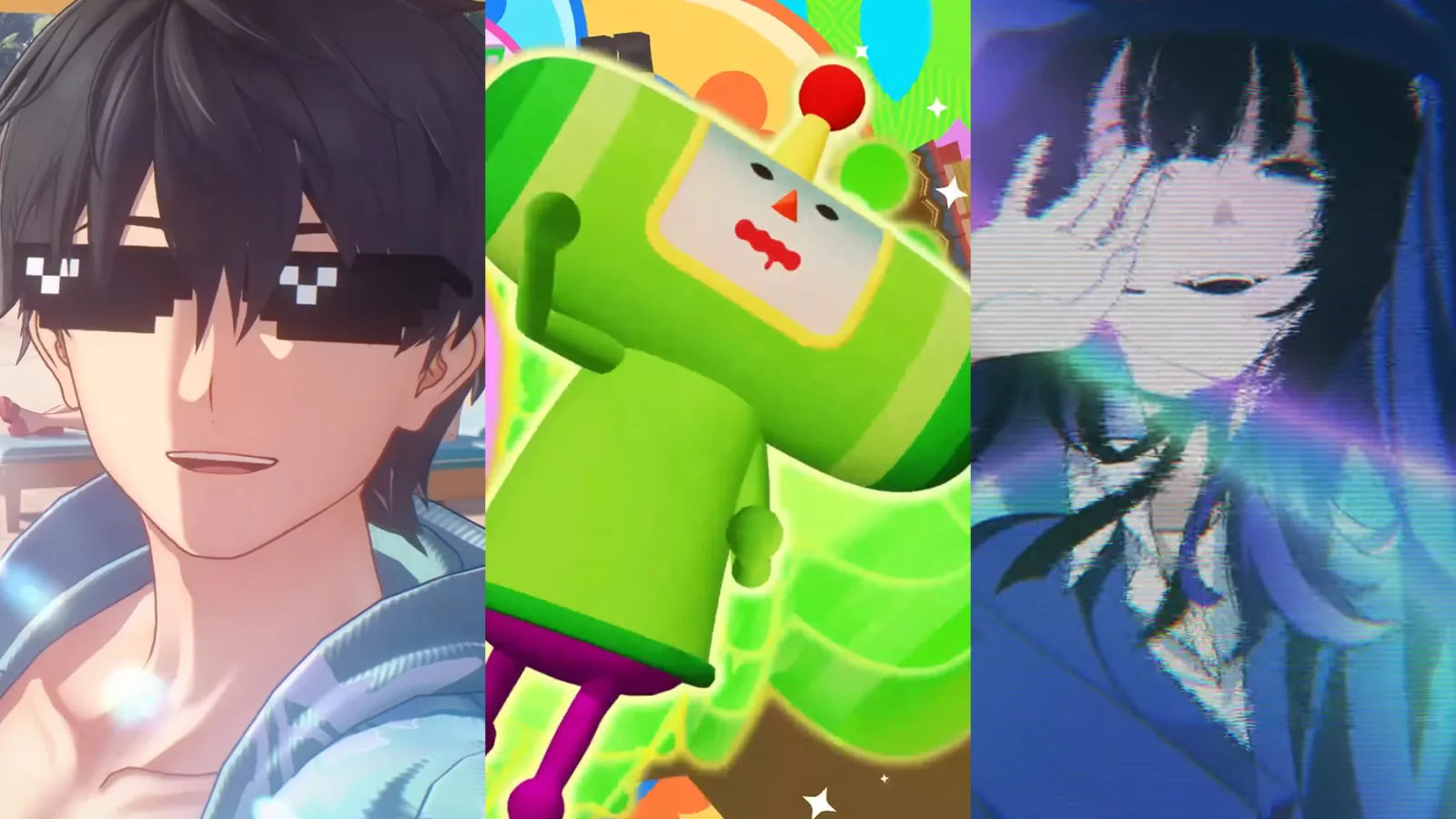
It’s fair to wonder if anyone, even a studio with the pedigree of Platinum Games, can create a Ninja Gaiden game worthy of the mantle left behind by Team Ninja, but if the demo at TGS is any indication, they’re more than capable. The section provided at the expo had players parkouring and grappling hooking around what looked like an industrial park as the new co-protagonist, Yakumo. The speed and responsiveness of the combat felt spectacular, as we dodged, jumped, and flashed into combat with a classic Flying Swallow slash.
As limbs were rendered, and heads separated from bodies, it quickly became clear that the 13 years that passed since the release of Ninja Gaiden 3 haven’t watered the violent action down in the least. The addition of Blood Raven attacks gives each of Yukimo’s armaments a powerful secondary form. His dual blades become a massive blood blade, while his staff transforms into a powerful drill-spear, piercing the hapless ninjas in our way in a shower of crimson.
The end of our demo had us face off against a massive enemy ninja with an aesthetic akin to TMNT‘s Super Shredder, and this demonstrated the other key use case for the Blood Raven Abilities. As we darted in and out to try to find openings to land blows without suffering reprisals, the boss would occasionally launch power attacks, indicated with a red exclamation point. These were unblockable, but with a perfectly timed Blood Raven attack, we could break the boss’s stance, cutting off the move and creating a window for punishment. It feels amazing to execute, and the Oct. 21 release date can’t come quickly enough.
If you love a good moody and atmospheric adventure game, know that Rain98, from Japanese indie developer and publisher C#4R4C3TR, has that style in spades. At its core, this is a visual novel about a modern-day protagonist suddenly waking up in a dirty apartment in 1998, and making a pact with the young woman there who claims to be a harbinger of the end of the world. Her total lack of alarm at the sudden appearance of a boy from the future makes her all the more intriguing, and she gives off an unmistakable aura that’s equal parts danger and excitement.
Reina, as we soon learn she is named, decides this time traveler needs a place to stay, and invites him to crash in her bathroom in exchange for doing whatever she demands, showcasing the surprisingly varied gameplay we clean her living room, point and click adventure style, and complete mini games assembling capsule prizes to earn cash.
It’s got a “Low-Fi Vibes to End the World To” aesthetic, mixing grainy, CRT-era anime visuals with a smooth jazz soundtrack. The story, while not quite horror, has a psycho-thriller tilt that had us hooked right from the start in our half-hour hands-on session. There’s no specific release date announced, though it’s expected to be available on Steam this year.
Ananta, previously known as Project Mugen, may have drawn the largest crowd at all of TGS, with lines filling up, and entire thoroughfares clogging as passersby stopped to watch the chaos unfold. The cell-shaded graphics over an open-world city with cars and guns have drawn comparisons to an anime GTA, which is apt, but when characters start smashing bad guys with tendrils and swinging through the city like Spider-Man, it becomes something altogether different, weirder, and awesome.
The demo opens with our character, Chenxiu, being attacked by a swarm of goons outside of a restaurant. The combat is reminiscent of the modern Arkham or Spider-Man games (almost shamelessly so), with punches, dodges, and counters leading to nasty (in a good way) takedowns. Chenxiu has some sort of tendril-based power, occasionally stretching out Venom-Like whips as he fights. After a few rounds of beating down bad guys, a sports car with a cat-eared lady behind the wheel crashes through the scrum, picking up Chenxiu in the process.
The fight turns into a car chase against dozens of motorcycles and spike-covered SUVs that would look at home in a Mad Max movie. At first, we are shooting out tires, gunners, and drivers as the passenger, then switch seats and race along a construction site, exploding those motorcycles as we run into them. Eventually, we swap back to the passenger seat, get flung out of the vehicle, and take down an evil semi in a series of quick time events.
The demo is as bonkers as it is fun, and, alongside the obvious GTA and Spider-Man inspiration, it’s reminiscent of a bit of a high-budget, modern take on Crackdown. If that “yes, and” design philosophy can work as well in a full game as it did in this short sample, then PlayStation, Windows, and mobile gamers are in for a helluva good time when this arrives, though a date has yet to be announced.
Cool-looking anime characters smashing monsters with swords is a pretty common sight at TGS, but the excellent combat and intriguing story of Duet Night Abyss made it really stand out from the pack. Our demo focused on an early part of the story, as you select one from a pair of protagonists, waking up with the classic anime case of amnesia in some strange land, guided by a mysterious companion who seemed to know more than she was ready to let on. The world, called Atlasia, is a mix of fantasy and machinery, and, as we reached a village that was eerily devoid of people, we were ambushed by a pack of what seemed to be some sort of robot-dog monsters, giving us an early taste of battle.
The high-speed sword action as I tore through these tech-monster things was impressive, mixing simple to execute, but elaborate-looking combos with a fast dodge to avoid incoming attacks. It was a lot of fun to rip the pack to shreds, especially when I got my cell-shaded hands on a gun. Suddenly, I was combining spectacular spinning slashes with bursts from my gun, switching back and forth with a seamlessness that would put Dante to shame.
Eventually, our path brought us to a boss fight against a woman wielding some sort of void-lightning power, and she quickly proved to be too much for my little duo. In a last-ditch effort, the protagonist merged with his companion, significantly boosting her power enough to overwhelm the boss, a possible glimpse at a mechanic that will apply to other companions you gather over the course of the game. It was just enough of a glimpse to leave me wanting more, and thankfully, the release is just a few weeks away, with a planned Oct. 28 release on Windows, Android, and iOS.
I admit it, I’m a sucker for the absolute zaniness of the Kamatari series, so I jumped at the chance to get an early hands-on with the upcoming Once Upon a Katamari, the first new entry in the franchise in 14 years. The demo was in Japanese, which I don’t speak, but somehow the King of All Cosmos screwed and destroyed the Earth and Stars, and the Prince needs to roll up everything in sight with his sticky Katamari and shoot it into space to fix it. We’ve all been there.
The big twist of this addition is that we are now rolling our Katamari through time. In this case, our playground was a feudal Japanese village. If you aren’t familiar, the gameplay hook of the Katamari series is that you roll a ball (the titular Katamari), which will pick up anything smaller than it. That means at first you can only grab small objects, but as the ball gets bigger, so too do the things you can grab, eventually reaching skyscrapers, entire islands, and other things of absurd scale.
Today, our goal was to reach a diameter of a little over 30 meters. I started rolling, grabbing a few shrubs while bouncing off trees and buildings. As the size ticked up, I managed to start grabbing lamp posts, villagers, and eventually graduated to entire buildings, as the cheery and bizarre music pumped in the background. It’s hilarious nonsense that promises to just get weirder as this entry rolls through time and space itself, and I can’t wait to try snatching up dinosaurs, ancient castles, and whatever other craziness Bandai Namco has planned for us when it releases on Oct. 24.
Square Enix’s Dragon Quest remakes aren’t just meant to redo the original; they are there to improve on their predecessors in meaningful ways, something, frankly, the gaming industry could learn some lessons from. We got to see an example of that at a brand new demo of Dragon Quest II HD-2D remake on the TGS floor, with the introduction of a massive new underwater world.
Without spoiling how or why, there will come a point in the story where your ship and party gain the ability to drop beneath the surface of the sea, exploring an area the size of the overworld itself. As we drop down, we are immediately greeted by a mermaid; it seems their kingdom is overrun by monsters. Heroes that we are, of course, we agree to help. Our journey takes us to the east, as we set sail for one of the brand-new underwater dungeons. The ship can rise and fall at will, allowing us to surface to avoid some underwater ridges, with occasional stops to fight off some ornery mollusks.
When we finally reach the dungeon, our crew disembarks, with a little personal air bubble around each. The dungeon is a maze of staircases, as we fight our way through random encounters with shellfish. The coral scenery looked spectacular in HD-2D, and even our small sample felt like a meaty new addition. The full version will feature new monsters, new dungeons, and a new city to explore, and promises to be a very worthwhile addition to the classic JRPG. The HD-2D remakes of both Dragon Quest I and II launch as a single package on Oct. 30.
If there is a Venn diagram where the gameplay The Legend of Zelda: A Link to the Past and the graphics of Dragon Quest HD-2D remakes converge, The Adventures of Elliott would be right at the center. This game, from the team that brought you Bravely Default and Octopath Traveler, wears its inspiration on its sleeve, as you swing your sword at monsters (and pots) in a classic SNES-style, semi-top-down viewed adventure.
The demo at TGS had us fighting our way through a swamp, activating switches to platform across the tops of lily pads to progress. It plays much faster than classic Zelda, both in terms of movement and combat. Elliott moves fast, especially with his legally distinct Pegasus Boots-like dash. His sword slashes cover a wide arc, and a dedicated shield button lets him hold up a block, or time one for right as an attack lands for a parry to create openings.
Eventually, we reached the boss, some sort of monstrous creature that looked like a cross between a toad and a catfish. The fight begins with the boss firing a veritable bullet hell of bubble attacks to dodge. When that doesn’t do the job, he switches to trying to inhale Elliott, which creates a perfect opportunity to throw a bomb in the boss’s mouth, stunning him while for a flurry of swings from my sword. As the battle raged, the intensity of the bubble-hell increased, and the boss called in massive tidal waves that could only be avoided by platforming across a series of lily pads. It was a great fight; the way it captures that classic Zelda boss-but-also-a-puzzle magic hit just right.
There’s no doubt that Monster Hunter is one of the biggest franchises in gaming. Monster Hunter World is Capcom’s best-selling title of all time, and its follow-up, Monster Hunter Wilds, is their fastest game to reach 10 million copies sold. When they invited us to check out Monster Hunter Stories 3, the latest in the turn-based RPG spin-off series, we jumped at the chance.
The demo starts with Leo, captain of the Rangers, taking a new recruit out for their first expedition. The Rangers are monster riders, fighting alongside tamed monsters called Monsties to preserve the local environment. Leo climbs about his trusty Rathalos and guides his recruit through the Blightstone Woods, a nearby area teaming with monsters. The console version of the previous entry, Monster Hunter Stories 2: Wings of Ruin, was exclusive to the Nintendo Switch; the higher resolution graphics and longer, more detailed draw distance are immediately apparent as we see a forest stretching over the surrounding cliffs.
Over the course of the demo, we battle several hostile monsters, including a velociraptor-like Velociprey, the furry flyer Paolumu, and a boss fight against a Feral Chatacabra, a twisted version of the large frog-monsters. Fights involve a rock-paper-scissors effect between Power, Technical, and Speed attacks, with the winner inflicting heavy damage, and the loser taking a big hit. Your Monstie tends to decide its attack for itself, but by charging your Kinship Gauge in battle, you can ride them, boosting your attacks and setting up spectacular ultimate attacks in the form of Kinship Skills. All together, it makes for a cool alternate take on the Monster Hunter formula, emphasizing a working relationship between monsties and riders as you hatch, ride, and battle alongside your monster companions.



